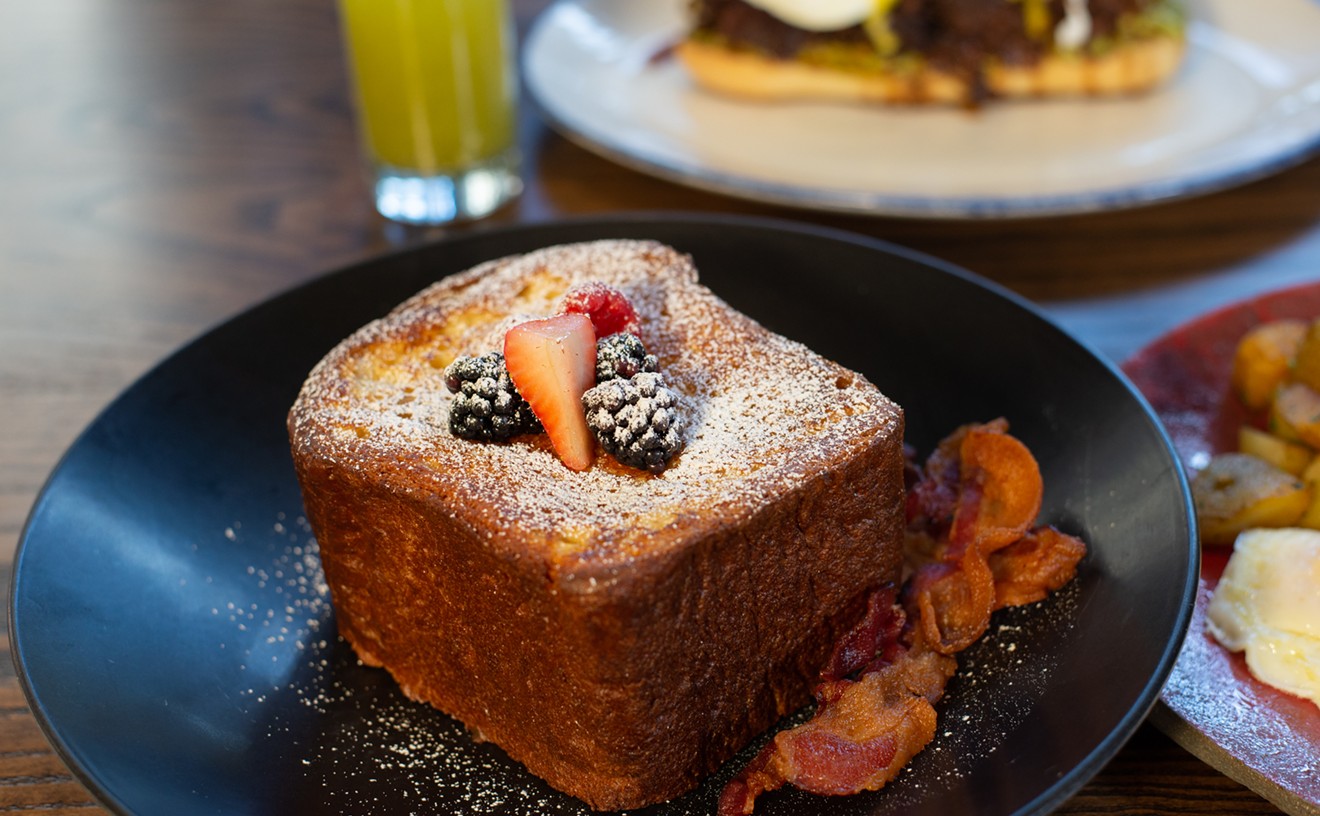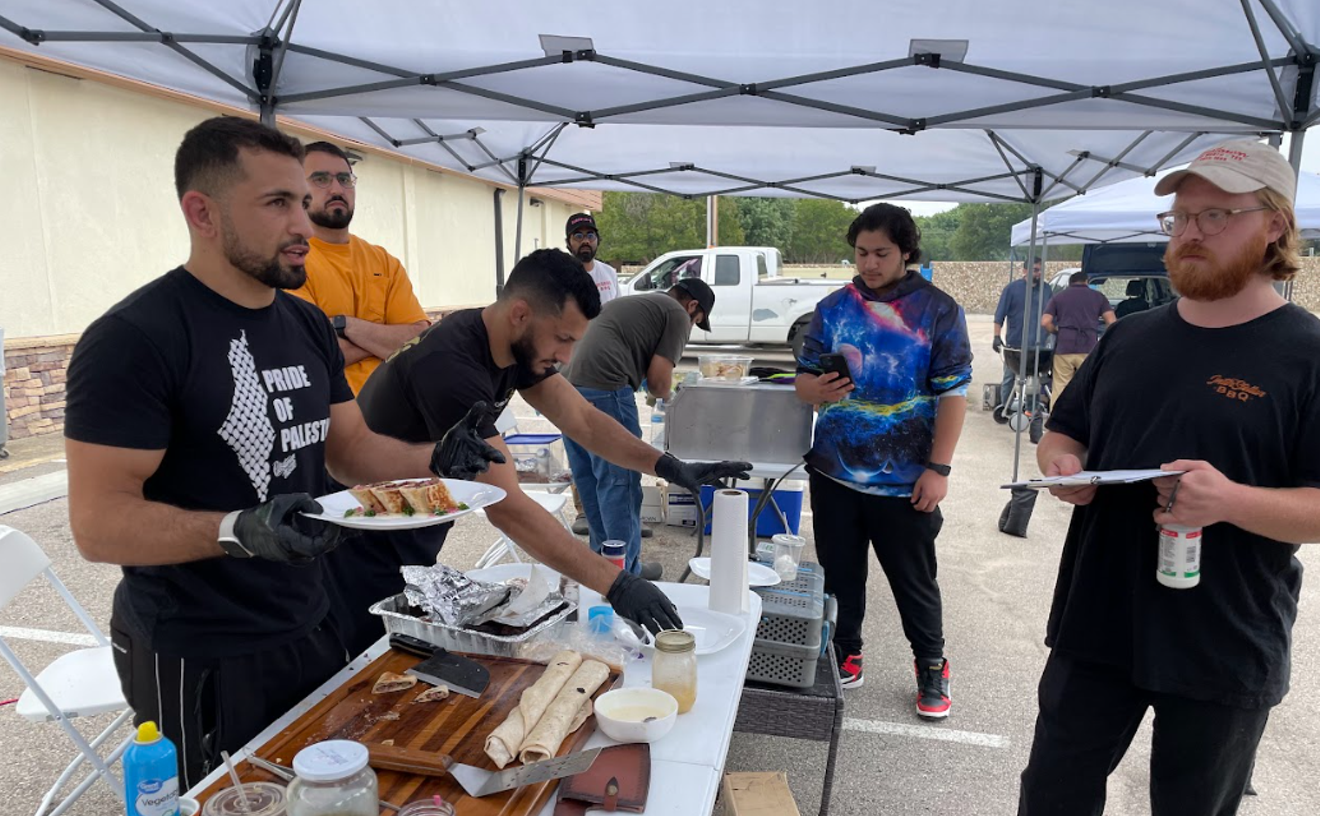And then there is this: Carpaccio is one of the few creations in culinary history whose birth can be pinpointed to a specific time, place, event, and inspirational germ.
Born in 1950 at Harry's Bar in Venice, the dish was created especially for an exhibition of the works of Vittore Carpaccio, an Italian Renaissance painter known for contrasting prodigious amounts of red with white. Giuseppe Cipriani, Harry's founder, developed the dish for a customer who could not eat cooked meat.
Raw steak is drizzled with creamy vinaigrette made with olive oil, cluttered with capers, and sometimes sprinkled with shavings of Parmesan cheese. This simple preparation survived virtually unadulterated until about a decade and a half ago. Now, it seems, virtually anything sliced to barely perceptible thickness can assume the carpaccio moniker--even when it's not completely raw.
My first exposure to carpaccio--some 12 years ago in Jerimiah Tower's restaurant Stars in San Francisco--wasn't even beef. Instead, paper-thin sheets of cured salmon were drizzled with a mayonnaise-based sauce, speckled with capers, and served with toast points. It was extraordinarily good.
Tuna, seared beef, seared lamb--even thin slices of mushroom--pilfer the name from this Harry's Bar invention. Carpaccio, it seems, so steeped in lustful simplicity, is susceptible to fits of imaginative manipulation.
Which is why I ordered it at Antonio Ristorante, a new Italian restaurant in Addison inserted into a street-level slot over which a brood of new upscale apartments is stacked. (Actually, the place is surrounded by construction rubble and debris, orange cones, and luxury-apartment skeletons, giving the whole area the look of a set piece from The Day of the Triffids. Given the nature of the venue and the recent evolution of the dish, I expected either a lushly authentic version or a provocative bending.
But I got neither. The ingredients were too banal in tone to compose an adequate replica of the original, and there was no artistic twist to pique curiosity. The meat, though visually striking, was bland and watery. Sprinkled with a few capers and some Parmesan, the flesh was void of dressing--not even a drizzle of olive oil to add luster to its vibrant weave of muscular tissue and fat. A tired grouping of marinated cauliflower, carrots, and celery had the harsh, aging tang of the pickled plant life proffered by warehouse clubs. Keeping company with these embalmed salad refugees were a few slices of fresh cucumber (good) and tomatoes (awful)--a surprise for a place with such a presumed pedigree.
A casual offshoot of the uptown restaurant La Trattoria Lombardi, Antonio Ristorante is a more casual spot. "I opened this restaurant for my chef. His name is Antonio," explains owner Luciano Cola, referring to Antonio Avona, the chef who helped him create La Trattoria. "This is a neighborhood restaurant, a friendly place with a nice little bar and TV and pizza." (When I called Cola to get information on his restaurant, he was a bit sarcastic and vague. He later admitted he thought mine was a crank phone call.)
Though I didn't sample the list of specialty pizzas, which includes versions from Tuscany, Sicily, and Piedmont, most areas of the menu I sampled quickly erased any misgivings left by that unfortunate carpaccio. In fact, at least three represented some of the best eating I've experienced in recent memory.
Insalata de arrugoloa, a patch of crisply supple arugala, radicchio, and Belgium endive, was blessed with tasty tomato, a spritely dressing, and rich roasted pine nuts.
Pasta e fagioli alla Toscana, pasta with cannellini beans, was astounding in its generous flavor and clarity. Avona cooks his beans with prosciutto--which adds richness--in chicken stock and adds shallots, garlic, a touch of oregano, and pepper flakes. The result is a hearty, well-balanced dish swelling with simple flavors and textures.
Hovering in the same vein, vongole con linguini is clustered with tender, chewy New Zealand clams in a white wine-butter sauce. It gushed with clean, sea-washed flavors. Avona spikes the dish with a bit of fish stock, which perks the tiny, slightly sweet clam meat with a smooth brininess.
And this is where Antonio seems to shine: simple preparations that transcend their ingredients, a dynamic Cola tries to capture in the decor. Brick and rustic wood trim dominate, while a stretch of windows separating the dining room from a large patio adds airiness. Tables are covered with white and green checked coverings, and decorative plates hang beneath sconces cast in that slightly unearthed look. It's all comfortable in an uninspiring way.
The wine list grabs this tone and drops it a few notches. Barely drinkable by-the-glass offerings are coupled with bottle batches too heavily populated with California stuff. With all the good, modestly priced Italian wine still attainable, it seems an oversight that this list isn't soaking in it.
A few dishes barely hover above uninspiring territory as well. The Caesar salad, splashed with a paucity of its underwhelming dressing, was simply adequate. And the way gamberi alla aglio con pasta--sauteed shrimp over pasta--is cast in menu lingo, you would think the dish is steeped in a simple, clean white wine sauce. Instead, the ingredients struggle in a plodding, viscous medium made from fish stock thickened with a roux (flour and butter). Plus, the shrimp, though strikingly sweet, were shy on succulence.
But the heightened tone was recaptured with pork chop alla campagna, a pair of grilled pork chops with rosemary and garlic. Avona roasts a pork loin to medium-rare and lets it cool before he cuts and grills chops to order. This settles the meat flavors while it seals in moisture. And the process works beautifully: the thick, slightly pink chops were juicy and tender, while the meat deftly absorbed the seasonings.
Originally from Southern Venice on the Adriatic Sea, Cola has made Dallas his home for the past 25 years. "Let me tell you," he says. "I could be very easily a spaghetti cowboy." No doubt one with a fistful of herbs.
Puff's claims to "build the best burger you ever tasted." And a press release lists the high-quality construction materials to prove it: a half-pound of freshly ground chuck; a custom-made toasted bun from Massimo's Italian Bakery; and an on-location hickory-smoking process. Everything is served in papered pie tins.
But if these are the ingredients of a great dining structure, how come everything feels like warped dry-wall and pressboard studs?
A clue that Puff's boasting is all blather is a burger ordered medium-rare on one visit. The limp, concave patty came with one edge firmly in the pink, while the middle and the opposite edge were well-done gray. Does Puff's freeze its building materials?
Flavor and texture were on the flimsy side as well. The meat is gristly and rubbery and lacks rich meat flavor, save for a cheap hint of smoke. Buns are chewy, bland, and shapeless. The pickle slices are discolored and mottled.
Sides have the flavor, texture, and appearance of rippled caulk beads. Onion rings were chalky, oily, and bland, while thin "shoestring cut" fries were cold, limp, and mushy--like a tangle of fish bait.
The fried shrimp was a little better than the burgers. The moist, curvy crustaceans actually displayed some sweetness and succulence, while the fried coating, though a little shy on flavor, was crispy.
The Mexican chef salad held promise, though it quickly fell into the mediocrity apparent in the rest of the menu. Generous chicken pieces, though juicy, were bludgeoned with hickory smog. Plus, the lettuce was limp and browning, while the tasty pintos touted on the menu numbered five. A paltry sprinkling of cheese and a single runt tomato wedge underscored the stingy squalor of this chef clutter fenced in by a greasy flour tortilla shell.
Puff's is the reincarnation of Cardinal Puff's, a longtime SMU hangout on Greenville Avenue and Yale that sputtered a few years ago because of a dispute between owner John Ahern and his landlord. This Preston Center reanimation is decked like an uppity greasy spoon. Walls are cluttered with battered windows and shutters, tables are draped in felt-backed beige vinyl coverings, and booths are dressed in striped fabric with blue vinyl trim.
For a simple grease trap, Puff's turns in an adequate performance. But for a venue boasting the best of anything, one thing's for sure: Puff's shouldn't have inhaled.
Antonio Ristorante, 4985 Addison Circle, (972) 458-1010. Open Monday-Thursday 11 a.m.-10 p.m., Friday 11 a.m.-11 p.m.; Saturday 4-11 p.m.; and Sunday 4-10 p.m. $$$
Puff's, The Hickory Grill. 6116 Luther Lane, Preston Center, (214) 362-6191. Open Monday-Saturday 11 a.m.-3 p.m. $-$$










